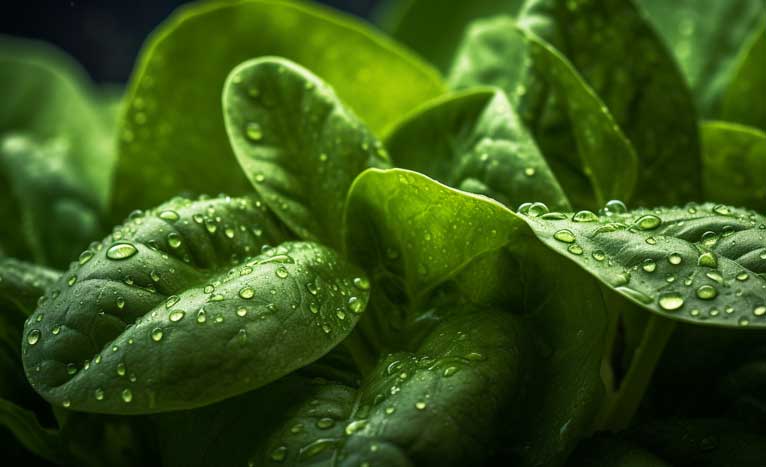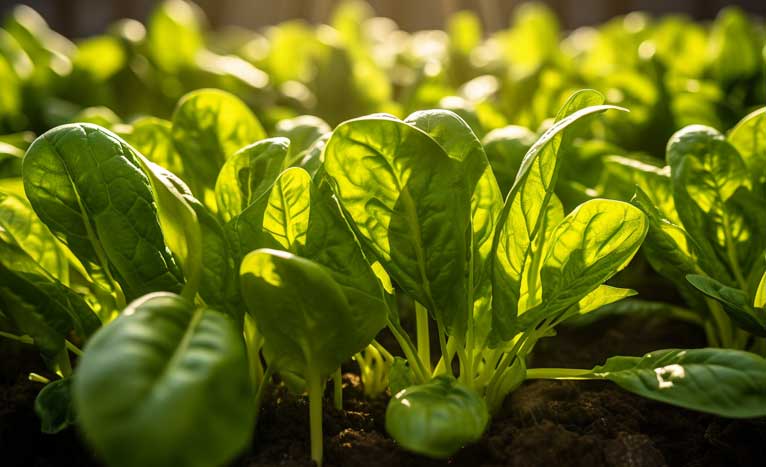Spinach is not just a leafy green vegetable; it’s a versatile, nutritious addition to any garden. Growing your own spinach means you’ll have a fresh supply of this healthful green on hand for your culinary needs. Not to mention, the satisfaction you gain from cultivating your food is second to none.
Every year, I grow a small salad garden on my homestead. As summer moves in, I like to have greens to make salads or to top sandwiches with. Spinach is an incredibly easy salad green to grow, you just need to get your timing right! Let me teach you how to grow spinach.
Why Grow Spinach?
Nutritional Value
Apart from the vitamins and minerals, spinach is also packed with numerous phytonutrients that have health-promoting and disease prevention properties. Regular consumption of fresh, organic spinach juice has been shown to improve skin health, increase vitality, and even contribute to the management of cancer, asthma, and diabetes.
Versatility in Dishes
Beyond salads and side dishes, spinach can also be baked into quiches, incorporated into omelettes, or mixed into sauces. Its mildly sweet flavor pairs well with a variety of ingredients, making it a creative addition to many dishes. Also, with the rising popularity of plant-based diets, spinach is a great source of plant-based protein.
Aside from its versatility in our dishes, it also serves as a treat for chickens! Yes, chickens love to shred apart greens, so spinach goes a long way in your garden for versatility of use! You can make a garden for your chickens that is filled with greens and once they have grown, allow your chickens to go in and till up the garden. They will eat the greens, till the soil, and compost it with their manure.
Getting Started
Best Time to Plant
While spinach can tolerate frost, it can't handle the heat. If temperatures climb too high, spinach plants bolt, or produce a flower stalk, which leads to bitter-tasting leaves. Therefore, timing your planting correctly is essential to ensuring a good crop.
For me, I plant my spinach in early spring. Frost is still happening, but the temperatures aren’t sub-zero. If I plant too close to summer when the temperatures are still relatively cool but can spike up sporadically as summer creeps in, I will end up with bolted spinach. When a cool-weather crop senses heat, it will think that it needs to go to seed and that its growing season is over. Keep this in mind for when you want to plant spinach. Your garden zone will determine when you plant spinach. Inquire with local gardeners.
Choosing a Variety
If you're looking for a heat-resistant variety, consider 'Tyee' or 'Palco.' For those interested in heirloom varieties, 'Monstrueux de Viroflay' is a French variety known for its large leaves and rich flavor. The variety you choose depends on your personal preference and the specific conditions of your garden.
Heirloom variety simply means that the seeds will be true to the parent. Hybrid seeds mean that if you save the seeds, they will not be true to the parent and you will get something different than what you originally grew. Heirloom varieties can be sourced locally as well. Other people in your area may have heirloom spinach varieties that they have grown in the area that do well in your climate. Heirloom seeds are valuable because you can seed save each year and continue on cultivating that crop in your garden from year-to-year.

Preparing the Soil
Soil Type
Enhancing your soil with compost not only improves its fertility but also its water-holding capacity, which is essential for the spinach's root system. Compost also introduces beneficial microorganisms that contribute to the overall health of the soil ecosystem.
Soil pH
Proper soil pH ensures optimal nutrient uptake. When the pH is too high or too low, certain nutrients become less available to plants. Using a soil test kit to determine your soil's pH level can be a useful first step in preparing your garden.
Planting the Seeds
Spacing
Proper spacing allows each plant to receive adequate sunlight, enhances airflow, and reduces competition for water and nutrients. Overcrowded plants can lead to reduced yield and increased susceptibility to diseases.
Depth
While spinach seeds need light to germinate, they also need to be in contact with the soil to access the moisture necessary for germination. Hence, covering the seeds lightly with soil provides the best environment for germination.
Germination
Maintaining consistent soil moisture is key for germination. If the soil dries out, the germination process may be interrupted, leading to lower germination rates. Using a gentle spray to water can prevent dislodging or unearthing the seeds.
Caring for Spinach
Watering
Spinach plants have shallow roots, so they tend to dry out faster than some other crops. Regular watering helps to keep the plants hydrated and promotes healthy growth. However, ensure the water drains well to prevent waterlogged soil, which can lead to root diseases.
Fertilizing
While fertilizing helps promote plant growth, over-fertilization can cause excessive leaf growth and delay maturation. A slow-release organic fertilizer, or a balanced liquid feed, is often sufficient for spinach.
Weeding
Weeding not only prevents competition for resources but also helps to reduce the chances of pests and diseases. Many pests and diseases overwinter in plant debris and weeds, so maintaining a clean garden can contribute significantly to the health of your spinach plants.
Pest and Disease Management
Common Pests
Other pests like cutworms and flea beetles might also invade your spinach patch. Cutworms can be prevented by placing collars around seedlings, and beneficial nematodes can control flea beetles. However, remember that a healthy plant is less likely to be attacked by pests, so providing optimal growing conditions is key.
Common Diseases
Fusarium wilt and bolting are other issues spinach growers might encounter. Fusarium wilt can be mitigated by ensuring the soil has good drainage, while bolting can be delayed by consistent watering and mulching to keep the soil cool.
Harvesting Spinach
When to Harvest
For continuous harvesting, start with the older, outer leaves, and work your way in, allowing the young inner leaves to mature. You can harvest repeatedly from the same plant throughout the season until it starts to bolt.
How to Harvest
If you're harvesting the entire plant, make sure to cut above the growing point, about 3 inches above the soil. This allows the plant to regrow for a possible second harvest. Harvest in the cool morning hours to ensure the leaves are crisp and filled with moisture.
Storing Spinach
Fresh Storage
If you don't plan to eat your spinach immediately, don't wash it before storing, as the moisture can promote spoilage. Instead, wash it right before you're ready to use it.
Freezing
You can also puree blanched spinach and freeze it in ice cube trays for easy addition to smoothies or soups. Regardless of how you choose to store it, homegrown spinach has a taste that's incomparable to store-bought spinach.
Growing your own spinach may seem like a lot of work initially, but once you get the hang of it, you'll find it's quite manageable, and the rewards are definitely worth the effort. There's something incredibly gratifying about harvesting a crop that you've grown yourself, especially when it's as beneficial for your health as spinach is.
My personal favorite part about growing spinach and including it in a salad garden is being able to grow food for my chickens. This saves on feed costs and is beneficial for the chickens and garden alike!
FAQs
Can spinach be grown year-round?
In cooler climates, spinach can be grown in the spring and fall. In warmer climates, it's best grown in the winter months.
Why is my spinach bolting?
Spinach plants bolt when the weather gets too hot. To delay bolting, keep the soil consistently moist and mulched to keep it cool.
How much sunlight does spinach need?
Spinach needs at least 6 hours of sunlight a day, but it also appreciates some shade in the hot afternoon sun.
How often should I fertilize my spinach plants?
Generally, a balanced fertilizer at planting and mid-growth should be enough. Always follow the product instructions.
Can I regrow spinach from cuttings?
Spinach doesn't regrow from cuttings, but if you leave a little stub of stem when you harvest, it might regrow a few leaves.

